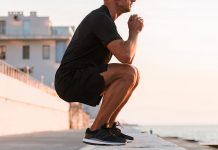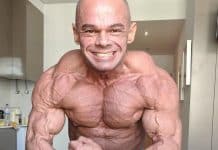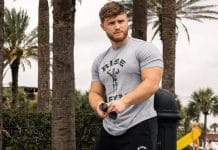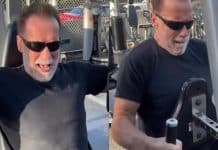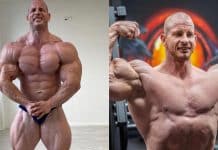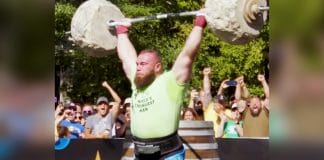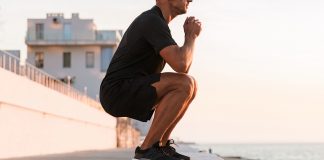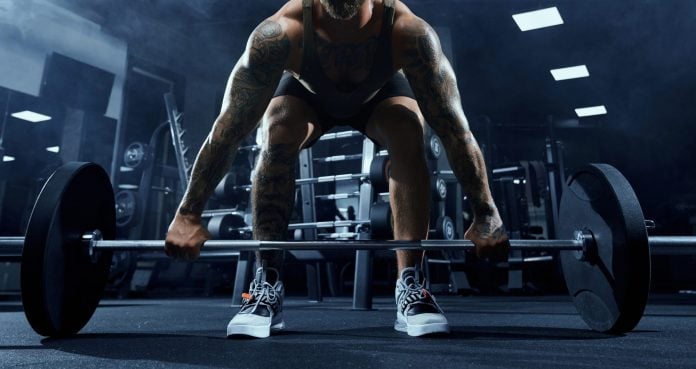
The Reeves deadlift activates other muscles compared to other deadlift variations.
The deadlift is a fundamental hip-dominant compound movement widely popular in gyms worldwide (1). It effectively targets the glutes, back, traps, hamstrings, and core. Among its numerous variations are the Romanian deadlift, sumo deadlift, and snatch grip deadlift. This post takes a historical dive back to the era before the Olympia competitions, focusing on Steve Reeves, a natural bodybuilder who achieved the Mr. Universe title twice and portrayed Hercules and Goliath in iconic films.
Reeves is credited with developing a distinctive deadlift technique known as the Reeves deadlift. Distinguished by its remarkable benefits for enhancing grip strength, the Reeves deadlift emphasizes the upper back and traps more than other variations.
This guide delves into the nuances of the Reeves deadlift, highlighting the specific muscle groups it engages. It also provides a detailed walkthrough on how to perform the Reeves deadlift correctly and outlines its key advantages. Continue reading for insights and three alternative exercises to bolster your grip strength, like the Reeves deadlift.
Techniques & Muscles Worked
The Reeves deadlift targets your hamstrings, quads, calves, adductors, abs, obliques, forearms, lats, traps, glutes, and spinal erectors. This excellent method of lifting will elevate your strength training to new heights, and your thumbs, fingers, and wrists will feel like they’ve had quite the workout.
You use a neutral and expanded grip to grip the weight plates to do the Reeves deadlift. Although you use a barbell during this routine, your hands don’t go there. Below is a step-by-step guide that explains how to do this routine correctly.
- Load the barbell with the appropriate number of weight plates and ensure that the smooth parts of the plates are facing in. Then, stand in front of the barbell with your legs shoulder-width apart.
- Push your hips back and bend forward at your hips and knees. Ensure your spine stays neutral and grasp the first plates on either side.
- Keep your arms straight and extend your legs and hips to lift the weight.
- Pause at the top, then hinge again at the hips to drop the weight and complete the rep.
Benefits
The Reeves deadlift is an old but gold routine. It’s beneficial for athletes who want to build their grip strength and can also be used as an accessory to the standard deadlift. Here are the benefits of doing the Reeves deadlift.
Greater Grip Strength
Gripping the weight plates instead of the barbell will greatly improve your grip strength. If your gym has plates with indents, they’ll help to make this routine easier. If not, you’ll have to pinch the plates with your fingers, building your strength even more.
Build Your Upper Back & Traps
The Reeves deadlift targets your upper back more than regular deadlifts. Having to grip the bar with your hands will work your traps. This could lead to more muscle hypertrophy in that area.
Strengthen the Core
You must use your core muscles to keep your spine neutral throughout this movement. As a result, you’ll build and strengthen the muscles there, which could also improve your stability and posture.
Greater Range of Motion
The wide grip needed to pick up the weight plates activates your shoulders and uses a greater range of motion. As a result, experts sometimes call the Reeves deadlift the scapular deadlift. Studies show a link between the range of motion used for exercise and increased muscle growth (2).
Reeves Deadlift Alternatives
The Reeves deadlift is an excellent routine for building grip strength. Did you know that multiple studies like this have linked grip strength to overall health and mortality rate (3)? Below are three other routines that you can use to enhance and build your grip strength.
Zottman Curl
The Zottman curl is a great exercise for building arms and strengthening grip. Rotating the dumbbells during this curl hits your biceps and forearms, strengthening your grip for exercises.
Kettlebell Swing
Kettlebells have a thicker handle than barbells or dumbbells. This automatically builds your grip strength whenever you use them. Doing a high-rep kettlebell swing will take this further by challenging your grip to some serious time under tension.
Dead Hang
The dead hang is an excellent bodyweight exercise for building your grip strength. Don’t let the simplicity of bodyweight exercises deceive you; this routine is surprisingly demanding. Aim for 20-30 seconds per hang, then add some weight to progress this routine.
FAQs
What does Reeves deadlift do?
The Reeves deadlift targets your posterior chain muscles just like standard deadlifts. However, they build your grip strength more due to the way you need to grip the weight plates. As a result, athletes use this routine as an accessory exercise for deadlifts.
Does Reeves deadlift increase shoulder width?
The Reeves deadlift significantly activates your shoulders due to the wide grip. This could lead to shoulder growth and more shoulder width. This exercise also focuses on and builds your upper traps.
Is Reeves deadlift safe?
The Reeves deadlift can be challenging but is safe with proper form. To be safe, start with lower weights for this movement. For more information on how to use the correct form for this exercise, please check the guide above.
Follow us on Instagram, Facebook, and Twitter for more exercise guides!
References
- Martín-Fuentes, I., Oliva-Lozano, J. M., & Muyor, J. M. (2020). Electromyographic activity in deadlift exercise and its variants. A systematic review. PloS one, 15(2), e0229507. https://doi.org/10.1371/journal.pone.0229507
- Schoenfeld, B. J., & Grgic, J. (2020). Effects of range of motion on muscle development during resistance training interventions: A systematic review. SAGE open medicine, 8, 2050312120901559. https://doi.org/10.1177/2050312120901559
- Bohannon R. W. (2019). Grip Strength: An Indispensable Biomarker For Older Adults. Clinical interventions in aging, 14, 1681–1691. https://doi.org/10.2147/CIA.S194543


